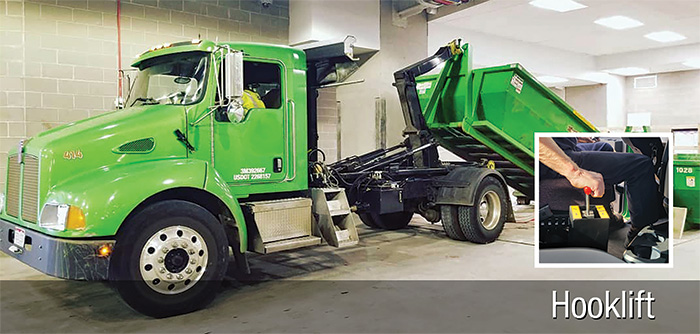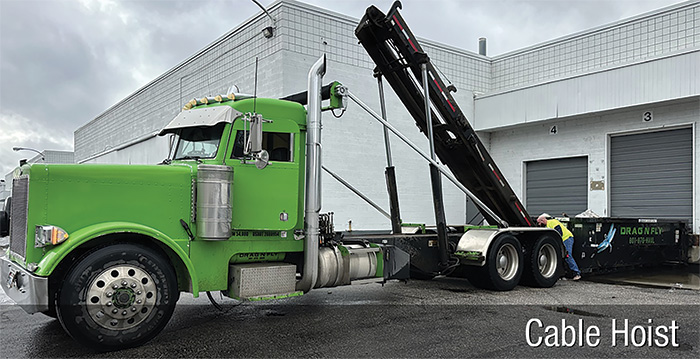While no fleet manager can guarantee a driver’s safety, most will agree it is wise to minimize risk in every way possible. Hooklifts deliver less risk and employees will appreciate it. You will improve your operation’s efficiency regarding time lost to injury, and reduce the potential for worker’s compensation claims and all the costs that come with them.
By Andy Jansma
When equipping your fleet to handle containers for recycling, refuse, scrap metal, or other roll-off applications, you will quickly come to a fork in the road: cable hoist or hook loaders? There is no denying the popularity of cable systems. They have been around the industry longer than hooklifts. They likely outfit more businesses and municipal fleets. Many drivers and mechanics are familiar with them. And, if you are shopping pre-owned, you will probably have a greater selection of used models from which to choose.
However, one factor strongly favors a hooklift. It is an important one when you stop to consider the well-being of your drivers, the efficiency of your fleet, and your operation’s potential exposure to costly worker’s compensation claims. We are talking about safety.

Inset: In-cab controls.
Why are Hooklifts the Safer Choice?
To compare and contrast systems, begin by reviewing how a cable hoist operates. For example, when loading, the driver lines up a dumpster. They step out of the cab. Extend the cable from the truck and attach it to the container. He or she then walks back to the chassis where truck-side-mounted controls let them haul aboard the load.
It seems simple and usually it is. However, when compared to a hooklift system, there is an easily avoidable risk at every step of the way. The hazards to a cable hoist become multiplied and magnified if a driver encounters bad weather during their workday.
Consider that when cab-side steps become slick from rain or snow, the driver’s safety boots can lose their grip. What’s more, every walk across muddy ground or icy pavement increases the chance of a slip-and-fall.
Other risks to cable operations are not weather-reliant. Man-handling a heavy and greasy cable can strain the driver’s body. Hooking it up often requires awkwardly bending over. Then, when ready, they must operate the cable hoist controls at the side of the truck—just feet or even inches away from moving machinery.
There is also the matter of safety chain hookups. Per DOT requirements, a driver must secure cable hoist dumpsters once the loading cycle has been completed and before hitting the road. No one can argue with the rule—but it adds another risk of injury to the cable hoist operator.

Photos courtesy of Ampliroll.
Superior Safety for Your Business or Municipality
When equipping your waste management or scrap hauling fleet, consider the superior safety offered by hooklifts in contrast to cable hoists. Hook systems eliminate nearly all of the risk to drivers when loading and unloading containers.
Why? Unlike cable systems, hooklifts feature cab-mounted controls.
When an operator picks up or drops off a container with a hooklift, they never have to leave the driver’s seat. There is no climbing in and out of the truck with the potential for missing a step or slipping off one.
Let it snow, sleet, or rain. With in-cab controls, a hooklift driver does not need to walk across rain-slick, snow-covered or icy ground. In these conditions, every step presents a challenge to drivers to stay on their feet and avoid a fall. Instead, the operator stays warm, dry, and safe within the confines of the truck.
Another plus to staying inside the cabin? Avoidance of added risk. There is no need to stand outdoors next to moving machinery to operate the controls and haul aboard the detachable. With each operation, a driver exposes themself to the hazards that come with it. Not so with a hooklift.
What’s more, most hooklift loads do not require attaching safety chains. The driver can skip this step and avoid yet another source of potential injury. The hydraulic hooklift itself secures the container to the truck and adheres to DOT standards.
Greater Safety: Tipping the Scales from Cable Hoists to Hooklift Systems
Cable hoist advocates will point out that their systems can operate in areas or buildings with lower overheads. That is true. A hooklift’s articulating jib requires greater clearance.
However, what is also true is that hooklifts enhance your operation’s efficiency. With all the operational steps they avoid because of their in-cab-controls, loading (and unloading) can take place in just a couple of minutes. For many waste and scrap operations today it often comes down to driver safety. And that is where one system easily outperforms the other: Hooklifts.
Bottom line? For anyone concerned with the well-being of their drivers, the efficiency of their operation due to lost man-hours from injury and their exposure to the expense of worker’s comp claims, the advantages lie with hooklifts. | WA
Andy Jansma is the U.S. General Manager for Marrel Corporation (Rockford, MI), Ampliroll Division. He has more than 35 years of experience with hook loaders and other waste equipment. Andy has also designed many types of specialized equipment for use in the waste industry. For more information, call (616) 863-9155, e-mail [email protected] or visit
https://amplirollusa.com.
